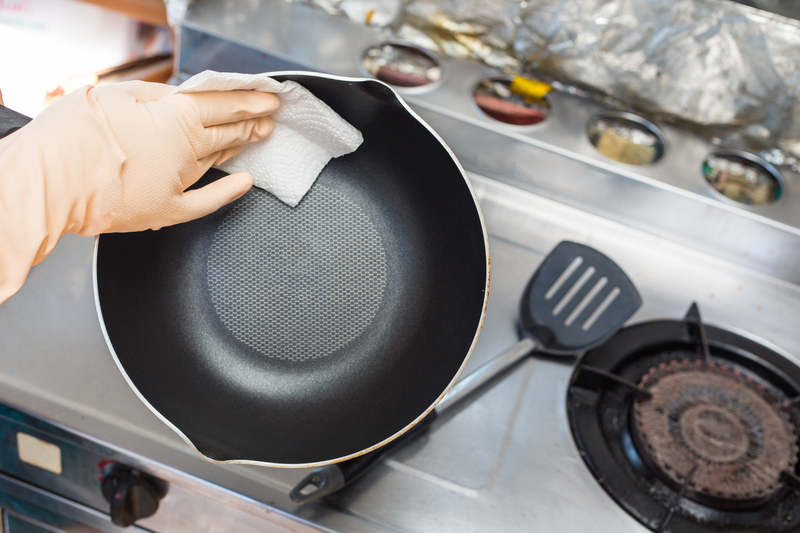From Musty to Fresh: Tackling Damp Smells
Posted on 20/06/2025
From Musty to Fresh: Tackling Damp Smells
Are dank, unpleasant odors creeping into your home and making your living spaces uncomfortable? Damp smells aren't just an annoyance--they can signal underlying moisture problems that may damage your property or even impact your health. In this comprehensive guide, we'll take you through everything you need to know to eliminate musty odors, transform your home environment, and keep it smelling clean and fresh.

Understanding Damp Smells: What Causes Musty Odors?
If you've ever walked into an old basement, closet, or bathroom and been hit by a stale, earthy smell, you're familiar with the classic musty scent associated with dampness. But what exactly causes these persistent smells?
Common Causes of Musty and Damp Odors
- Excess Moisture: High humidity, water leaks, and condensation provide the perfect breeding ground for musty odors.
- Mold and Mildew Growth: Fungi thrive in dark, moist conditions and release compounds called microbial volatile organic compounds (MVOCs)--the source of musty smells.
- Inadequate Ventilation: Poor airflow prevents moisture from escaping, letting smells accumulate and propagate.
- Organic Material Decomposition: Dust, wood, fabric, and even dirt in perpetually damp places can decompose, triggering an earthy, unpleasant scent.
*Damp, musty odors* are not just a surface issue; they're often a sign of hidden moisture problems that need attention to prevent further complications. Addressing these smells isn't just about making your home inviting--it's also about protecting it from potential structural damage and health risks.
Why It's Important to Get Rid of Damp Smells
Ignoring a damp, musty smell is a mistake many homeowners make. Besides being unpleasant and embarrassing when guests visit, the presence of persistent damp odors can have more serious long-term consequences.
- Health Risks: Mold can trigger allergies, asthma, and other respiratory issues, especially for sensitive individuals, children, or elderly people.
- Structural Damage: Over time, excess moisture can weaken wooden structures, damage drywall, and increase the risk of infestations by pests drawn to damp conditions.
- Decreased Property Value: Musty homes are less attractive to buyers and can lower your property's market value.
- Lingering Odor: The longer you leave a damp smell untreated, the more difficult it can become to fully eliminate it.
By tackling the root causes of musty smells, you'll protect both the health of your family and the integrity of your property.
Step-by-Step Guide: How to Get Rid of Damp Smells
Ready to leave those stuffy, musty rooms behind? Here's a comprehensive guide to eliminating damp odors and transforming your living space into a fresh, healthy environment.
1. Find and Remove the Source of Moisture
- Inspect for Leaks: Check pipes, roofs, basements, and windows for leaks or condensation. Even minor drips can lead to significant problems if left unaddressed.
- Seal Cracks and Gaps: Use appropriate sealants to fix cracks in walls or foundations where water might enter.
- Improve Grading and Drainage: Ensure the land around your home slopes away to prevent water from pooling near your foundation.
2. Boost Ventilation
- Open Windows and Doors: Letting fresh air circulate helps remove stagnant, moist air and replace it with drier, cleaner air.
- Use Exhaust Fans: Install or use fans in high-moisture areas like bathrooms, kitchens, and laundry rooms.
- Install Trickling Vents: Small vents in window frames enable a constant flow of air, helping prevent moisture buildup year-round.
3. Dry Out the Area
- Deploy Dehumidifiers: Use a dehumidifier to actively remove excess moisture from air--especially in basements and other enclosed spaces.
- Absorb Moisture: Place moisture absorbers (e.g., silica gel, activated charcoal, or calcium chloride-based products) in closets and cabinets.
- Increase Heating: During cooler months, a small heater can help evaporate moisture more quickly.
4. Remove Mold and Mildew
- Clean Affected Surfaces: Wipe down walls, tiles, and other hard surfaces with a solution of water and white vinegar or hydrogen peroxide (never mix bleach and ammonia!).
- Launder Fabrics: Curtains, linens, and upholstery can trap musty smells--wash them with hot water and detergent.
- Throw Away Contaminated Items: If mold has taken hold in carpets, drywall, or ceiling tiles, these may need to be replaced.
5. Deep Clean and Deodorize Your Home
- Vacuum Regularly: Dust and organic debris contribute to musty odors--keep floors and surfaces clean.
- Steam Clean Carpets and Upholstery: Deep cleaning removes trapped moisture and bacteria from fibers.
- Natural Deodorizers: Bowls of baking soda, white vinegar, or coffee grounds can absorb lingering smells without artificial fragrances.
6. Prevention Is Key
Once you've banished musty odors, keep them at bay with these prevention strategies:
- Regular Checks: Inspect problem areas during each season for signs of dampness, leaks, or mold.
- Consistent Airflow: Don't block vents or air returns; use ceiling fans to keep air moving.
- Control Humidity: Aim for indoor humidity levels between 30-50% using dehumidifiers or air conditioners as needed.
- Store Items Off the Floor: In basements or garages, keep boxes and fabrics on shelves rather than directly on the (often colder, damper) floor.
- Invest in Moisture Barriers: Vapor barriers and waterproofing treatments for walls and floors can be a smart long-term investment in damp-prone areas.
Best Products for Tackling Damp and Musty Smells
Not sure what to use to fight musty, damp odors? Here are some of the most effective cleaning agents, household products, and tools that make a difference:
- White Vinegar: Cuts through mold and neutralizes odors naturally--wipe surfaces or place bowls to absorb smells.
- Baking Soda: Absorbs and neutralizes tough odors when sprinkled on carpets or furniture.
- Activated Charcoal: Powerful at absorbing both moisture and odors; place in rooms or closets for ongoing freshness.
- HEPA-Filter Air Purifiers: Removes particulates and airborne mold spores for fresher air.
- Mold & Mildew Cleaners: Look for EPA-registered products specifically formulated for heavy mold issues.
- Essential Oils (Lavender, Tea Tree, Eucalyptus): Add a few drops to cleaning solutions for antimicrobial benefits and a natural scent.
- Desiccant Packs: Great for small spaces like drawers, closets, or under sinks to absorb moisture over time.
Special Tips for Common Damp-Prone Areas
-
Basements:
- Waterproof walls with sealant paints.
- Get a high-capacity dehumidifier.
- Install a sump pump if groundwater is an issue.
-
Bathrooms:
- Use an exhaust fan during and after showers.
- Wipe down tiles and grout regularly to prevent mildew buildup.
-
Closets & Storage Rooms:
- Keep doors open occasionally for ventilation.
- Store clothes clean and dry; use garment bags if possible.
-
Attics:
- Check insulation for wet spots after rain or snow melt.
- Ensure eaves and vents are clear for airflow.
Natural Methods to Eliminate Musty Smells
If you prefer eco-friendly techniques or want to avoid harsh chemicals, these methods are safe, affordable, and highly effective:
- Lemon Juice: Its acidity helps disinfect surfaces and leaves a pleasant, natural fragrance.
- Bamboo Charcoal Bags: These reusable bags absorb both moisture and odor--place one in each closet or storage area.
- Houseplants: Some indoor plants (such as English ivy and Boston fern) help absorb moisture from the air and filter out contaminants.
- Sunlight: Where possible, open curtains and let direct sunlight reach musty areas; UV rays help kill mold spores and reduce humidity.
How to Tell If the Musty Smell Is Gone
- Physical Inspection: Check for visible mold, peeling paint, or condensation. If these signs are gone, your efforts are paying off.
- Odor Test: Step out of the affected room for a few minutes, then re-enter. Is there a noticeable stale smell?
- Humidity Meter: Use a hygrometer to check for moisture. If indoor levels are consistently below 50%, you are on the right track.
Remember, sometimes your sense of smell becomes accustomed to an odor; it can help to get feedback from someone who doesn't live in your home.

When to Call a Professional
If despite your best efforts the damp and musty smell persists, professional intervention may be needed. Hidden leaks, widespread mold, or chronic humidity problems can require specialized tools and treatment. Consider calling a certified mold remediation or water damage specialist if:
- The affected area is larger than 10 square feet.
- Mold keeps returning after cleaning.
- There is obvious structural damage or visible black mold.
- People in your household are experiencing health symptoms linked to mold exposure.
Professionals can identify hidden sources, safely remove dangerous materials, and recommend permanent solutions.
Conclusion: Transform Your Home from Musty to Fresh
No one wants to live in a home haunted by the stale, musty odor of dampness. With a strategic approach--identifying and fixing moisture issues, cleaning thoroughly, ventilating well, and taking preventative measures--you can reclaim your living spaces and enjoy a clean, healthy, and fresh-smelling environment.
To recap, here's your roadmap for tackling damp smells:
- Find the source of moisture and fix it.
- Ventilate and dry out affected areas.
- Remove mold and mildew, and clean thoroughly.
- Use moisture absorbers and natural deodorizers.
- Take proactive steps to prevent future problems.
If you prioritize regular inspection and invest in ongoing moisture control, your home can stay inviting and odor-free year-round. Say goodbye to musty, damp smells--and hello to a fresh, healthy home!





